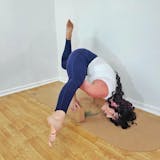Yoga is a practice that promotes harmony between the body, mind, and soul.
But have you ever thought of the impact of your yoga wear on the environment and the people who create it for you?
If you haven't, remember that these practices have severe negative effects on both parameters.
On the contrary, Sustainable yoga wear is a great alternative to fast fashion items that harm the planet and exploit workers.
In this article, we'll explore the benefits ofsustainable yoga clothing and provide tips for taking care of your eco-friendly and ethical garments.
Why Choose Sustainable Yoga Wear?
Sustainable yoga wear is made with eco-friendly materials that minimize the environmental impact of textile production. It is also produced under fair working conditions that respect workers' rights and promote their well-being.
Here are a few reasons to consider choosing sustainable yoga wear:
1. Environmental Benefits: Sustainable yoga wear is made from organic, upcycled, or recycled yoga clothes that reduce waste and pollution. Organic cotton, for example, is grown without harmful pesticides and fertilizers, which protects soil health, water quality, and biodiversity.
3. Health Benefits: Sustainable yoga wear is free of toxic chemicals that harm your health and cause skin irritation, allergies, or respiratory problems. It is also more breathable and comfortable than synthetic fabrics that trap moisture and odor.
Types of Sustainable Yoga Wear
1. Organic cotton yoga wear: Made from cotton grown without harmful pesticides or synthetic fertilizers,organic cotton yoga clothing
is an eco-friendly and sustainable option. It is soft and breathable, making it ideal for yoga practice.
2. Bamboo yoga wear:Bamboo fabric is a sustainable and durable material made from bamboo pulp. It is soft, moisture-wicking, and naturally anti-bacterial, making it a great option for yoga wear.
3. Recycled polyester yoga wear:Made from recycled plastic bottles and other post-consumer waste,recycled polyester yoga clothing
is an eco-friendly alternative to traditional polyester. It is lightweight, breathable, and moisture-wicking.
4. Linen yoga wear: Linen is a biodegradable and sustainable yoga wear
material made from the flax plant's fibers. It is lightweight, breathable, and moisture-wicking, making it a great option for yoga wear.
5. Wool yoga wear: Wool is a natural and renewable material that is great for yoga wear. It is warm, moisture-wicking, and naturally anti-bacterial, ideal for colder climates or cooler yoga practices.
Tips for Taking Care of Your Sustainable Yoga Clothing
Here are some tips for washing, drying, and storing your ethical and eco-friendly garments:
1. Read the Care Label:
Reading the care label is essential to ensure the longevity of your sustainable yoga wear. The care label provides specific instructions on washing, drying, and ironing your garment to maintain its quality and appearance.
Always follow the instructions to avoid damaging the fabric or shrinking the garment. If the care label recommends hand washing or dry cleaning, it is best to follow these instructions to avoid damaging the garment in the washing machine.
By reading the care label, you can ensure that your sustainable yoga wear lasts longer and continues to look great.
2. Wash in Cold Water:
Washing your sustainable yoga wear in cold water is a simple yet effective way to help preserve the fabric and minimize its environmental impact.
Hot water damages the fibers and causes shrinkage, leading to a shorter lifespan for your garment. By washing in cold water, you also use less energy, as heating water accounts for a significant portion of a washing machine's energy usage.
Additionally, washing in cold water reduces your carbon footprint by minimizing the energy needed to heat the water.
Washing your sustainable yoga wear in cold water is a small but impactful step in reducing your environmental impact.
3. Avoid Bleach and Fabric Softener:
These softeners may seem like helpful laundry additives, but they can harm the environment and your sustainable yoga wear.
Bleach damages the fabric, fades colors, and harms aquatic life when it enters the water supply. It leaves a residue on the fabric that traps bacteria and odors, leading to a less clean garment.
Additionally, fabric softeners often contain harmful chemicals that are not biodegradable and harm the environment. It is best to avoid using bleach and fabric softener in your laundry routine to keep your sustainable yoga clothes looking great.
4. Air Dry or Low Heat Dry:
Air drying or using low heat when drying clothes extends the life of your sustainable yoga wear. The high heat from a dryer can damage the fibers and cause shrinkage, leading to a shorter lifespan for your garment.
Air drying is the gentlest option and allows the garment to dry naturally without the risk of damage from heat. If you must use a dryer, select a low heat setting to reduce the risk of damage to the fabric.
By opting for air or low-heat drying, you can help maintain the quality of youreco-yoga clothes for longer.
5. Store in a Dry and Clean Place:
Proper storage is crucial to maintaining the quality of your sustainable yoga wear. By properly storing yoursustainable yoga clothing, you can ensure they remain in great condition and last many years.
After washing, ensure that the garment is completely dry before storing. Moisture leads to mold and mildew growth, which damages the fabric and causes odors.
Store your sustainable yoga wear in a clean, dry place protected from dust and direct sunlight. Hanging the garments on a hanger or folding them neatly in a drawer can help maintain their shape and prevent wrinkles.
6. Never dry clean:
Dry cleaning is a process that uses harsh chemicals that can be harmful to the environment and youreco-friendly yoga clothing.
These chemicals strip the fabric of its natural oils and cause it to break down over time, which leads to a shorter lifespan for your garment.
Additionally, dry cleaning is an energy-intensive process that contributes to carbon emissions. It is recommended to avoid wearing items that need dry cleaning and to wash your clothes according to the care label recommendations.
By choosing to skip dry cleaning, you may preserve the quality of your sustainable yoga clothes and minimize their environmental impact.
7. Washing similar colors together:
Washing similar colors together is important in caring for sustainable yoga wear. This helps to prevent color bleeding and dye transfer from one garment to another, which may cause discoloration and fading.
Separating your darks, lights, and brights into different loads can help prevent this issue. Additionally, washing similar fabrics together can help prevent damage to the fabric caused by rougher materials.
By washing similar colors together, you may preserve the quality and appearance of your sustainable yoga wear for longer and reduce the need to replace garments due to color damage.
8. Turning your garments inside out
Turning them inside out before washing them is a simple yet effective way to protect the outer layer of the fabric and maintain color vibrancy.
This is particularly important for sustainable yoga wear, as it can help to prevent damage to the fabric caused by friction from the washing machine.
Turning your garments inside out helps to reduce the amount of rubbing against other items during the washing process. This, in turn, helps to prevent pilling, snags, and other types of damage to the fabric's surface.
As a result, your sustainable yoga clothes will look and feel better for longer, reducing the need to replace garments due to damage.
9. Eco-friendly detergent:
A gentle, eco-friendly detergent is key in caring for your sustainable yoga wear. Traditional laundry detergents contain harsh chemicals that harm the environment and your garments.
On the other hand, eco-friendly detergents are made with natural ingredients and are less likely to cause damage to the fabric. These detergents are also biodegradable, which means they break down more easily in the environment and produce less waste.
Choosing a gentle, eco-friendly detergent may protect both your sustainable yoga wear and the planet.
10. Consider handwashing:
Consider handwashing your light sustainable yoga wear to avoid damage from the washing machine. Handwashing allows you to control the amount of agitation and temperature, which can help preserve the fabric's integrity.
This is particularly important for garments made from delicate fabrics, such as organic cotton or bamboo, which can be easily damaged in the washing machine.
When hand washing, use a gentle, eco-friendly detergent and avoid wringing or twisting the fabric to prevent damage. Instead of gently squeezing the excess water, lay the garment flat to dry.
By taking the extra time to handwash your sustainable yoga wear, you can extend its lifespan and reduce the need to replace it due to damage.
Caring for your sustainable yoga wear is essential to maintain its quality, longevity, and eco-friendliness. You may ensure that your yoga attire endures many workouts and stays in outstanding shape by paying attention to the advice in this manual.
Always wash delicates in cold water, use mild detergent, stay away from fabric softeners and chlorine, and let them air dry as opposed to using a dryer. Try to avoid washing your clothes as much as possible by spot-treating stains and letting your clothes air out after each wear.
By taking care of your sustainable yoga clothing
, you can save money and contribute to reducing your environmental footprint. Try out Green Apple's yoga clothes and continue practicing yoga sustainably 










